The SEO (search engine optimization) market in the United States is expected to reach $80 billion by 2020. Businesses large and small are investing more into organic, online traffic. The legal services industry is by far one of the most competitive verticals within search engine marketing, with an average cost per click prices for AdWords of $54 per click, according to WordStream.
While there are many ranking factors (over 200) that Google’s search algorithms take into account, it’s easy to get lost in the noise if you’re seeking to improve your law firm’s website rankings in the search results. We looked at 12 common attributes including tools and technologies used as well as SEO metrics, to see what the top-ranking (in Google) law firms were doing and share in common.
12 Things Top Law Firm Websites Are Doing
Rather than consider this list simply as SEO and ranking factors, it’s more accurate to think of what the top-ranking law firms are doing to get so much out of their SEO. You’ll see trends and have a clearer understanding of how you should measure your practice’s website against the competition.
1. Most Page 1 Websites are Secured with SSL Certificate
While this is without a doubt, a small contributor to SEO rankings, we found that the overwhelming majority of first-page law firm sites have an SSL certificate installed. In fact, 89% of all websites in the study had a valid SSL certificate. Furthermore, as we crawled deeper pages (2-10), there were still plenty of sites ranking much lower with HTTPS, but there was a drop-off of approximately 30-40% depending on the area of law and city. There are a few things this goes to show:
There are a few things this goes to show:
- There are plenty of secure, HTTPS-enabled websites ranking in the top 100 results. This isn’t exclusive to page 1 results.
- It’s a sign of security, but also attention to detail and extra professional edge (on the part of the designer/webmaster)
2. Use of Professional Photos
91.5% of the ranking web pages from law firm sites included in the study used at least one relatively recent, professional photo on the ranking page. These photos could be custom or bespoke graphics, photos of the local city, office interior, exterior or team photos.
57.3% of the ranking firm’s web pages used recent, crisp photos of the team or primary attorney of the practice. There was trend variance based on the area of practice. 79.2% of personal injury lawyers ranking on the first page of Google had at least one team or attorney photo on the ranking page. The lowest keyword segment, bringing the overall average down were mid to large-sized, full-service law firms – only showing an attorney or legal team photo on the page 35.3% of the time.
This may isn’t explicitly a ranking factor for organic search. However, it is arguably a part of the user experience. UX is something measured across multiple metrics that search engines do take very seriously. Aside from the home page of a law firm’s website, the most-widely clicked on pages on a law practice or attorney’s website is their profile pages. Therefore, having good headshots and team photos can improve the amount of time spent on-page.
3. Backlinks & Referring Domains
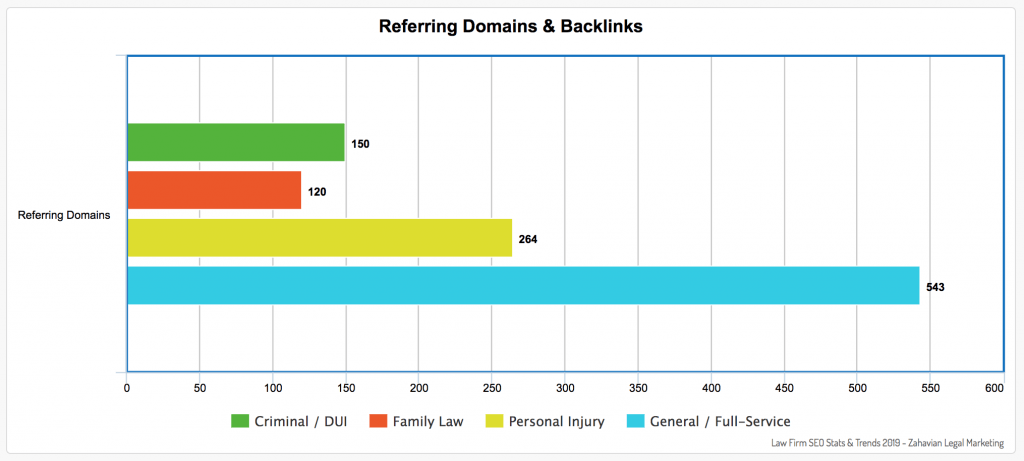
Backlinks and Referring domains are a substantial factor (many SEOs argue the largest) in the overall authority and ability a website has to rank.
The average number of backlinks across all of the law firm’s websites measured was 49,766 links per website and 256 referring domains. However, there were significant differences when segmented by keyword or area of law.
| Keyword / Area of Law | Backlinks | Referring Domains |
| Criminal Lawyer | 5,744 | 150 |
| Family Lawyer | 3,057 | 120 |
| Personal Injury Lawyer | 25,069 | 264 |
| Law Firm | 194,441 | 543 |
| Aggregate / Total | 49,766 | 256 |
As we can see, the larger, full-service law firms have vastly more links and referring domains than even the runner-up (personal injury law) with on average slightly less than half the number of referring domains. However, this large variance was produced by several full-service law firms, rather than a general trend across the entire collection. In fact, many full-service law firms large and small were able to rank in the results. Of all the firms, ones that ranked in the first SERP for law firm had the largest standard deviation of referring domains and backlinks. Results, while varied, were for more consistent for the other keywords.
Why is there a large difference between Full-Service and Specialty Law Firm Backlinks?
While the aggregate number of backlinks may seem high, it’s skewed by the nature of the law firms in the dataset. The dataset could be split into two categories when observing the firm size. When searching on google, generically for “law firm houston” rather “personal injury lawyer houston,” a significant portion of the law firms ranking on page one was substantially larger than the firms ranking for family, criminal and personal injury keywords.
Why Measure Backlinks instead of Domain Authority?
There are many different domain and page authority scoring and ranking tools on the market, such as Moz, Majestic and Ahrefs. However, they’re all different ranking algorithms used to approximate and model that of Google’s. None of them are exact and Google’s John Mueller has denied that Google even uses a “Domain Authority” as a ranking signal.
Backlinks and referring domains are just simpler metrics. By only measuring the quantities, we can see a clear, non-trademarked look at a website’s link strength and estimate it’s authority based on that, instead of relying on a 3rd-party domain rating system.
4. Ranking Page’s Word Count
As far as on-page SEO goes, word count, itself isn’t a direct indicator of page relevance but does indicate the quantity of writing required to make one’s point. Across the board, the average word count was 944 words. Criminal and Family law came in relatively close together at 921 and 903 words, respectively. Personal injury had the largest average word count at 1304 words and the lowest were practices ranking for “law firm” in general at an average of 597 words.
5. Choosing a Domain Name for your Law Firm
Every website needs to start with a domain. This is the base URL (e.g. example.com) that every one website has as its address on the web. We looked at the domains of the law firm’s websites studied and were able to classify them as:
- Branded
- PMD / EMD (Partial / Exact Match)
There has been much debate and controversy over the use and effectiveness of EMDs or Exact Match Domains. In essence, these are domains like “www.personalinjurylawyernyc.com”. What makes it an exact match domain is that it contains all of the target keywords that the website desires to rank for (i.e. personal injury lawyer + nyc). Many from the web and search teams at Google have said that they’re neither good nor bad for the performance of a website in terms of SEO and that it depends on giving the user excellent experience. We’ll let you judge for yourself after reviewing the results below.
Results
Across the four varieties of keyword searches conducted, over 41% of practice websites ranking on the first page results organically used an exact or partial match domain. There were several interesting points observed in the data.
First, the segment of law firms’ websites with the highest number of EMD or PMDs was from “criminal law” search terms, with approximately two-thirds of the sites bearing a domain name with 2 or more keywords contained in the search query. This was followed by family law with just under 48% and personal injury coming in lowest at 25%.
Domain Name’s Effect on Measured Properties & SEO Metrics
There were also interesting relationships found between domain names and SEO metrics that we measured. Namely, the average word count, keywords, estimated site traffic and referring domains.
There was a slight difference in the average word count. Websites without exact or partial match domains had, on average, over 12% more words on the ranking page than sites with EMD/PMDs (961 vs. 855 words).
However, words are easy to write. Links are much more difficult to acquire. Domains considered as exact and partial match class had far fewer referring domains than those that weren’t. The data is shown below.
| Domain Name Type | Avg. # Referring Domains | Net (%) from Aggregate |
| EMD / PMD | 215 | -16.0% |
| Non-EMD / PMD | 285 | +11.3% |
| Aggregate | 256 | – |
In other words, Non-EMD / PMD websites had 32.6% more referring domains than exact or partial match domains. This points to the hypothesis that, keyword-rich (EMD/PMD) domain names can perform on par with solely branded domain names with significant fewer links. It could be argued that this is accounted for in the search engine’s algorithm considerations for E-A-T.
Relationship Between Keywords, Est. Organic Traffic & Domain Names
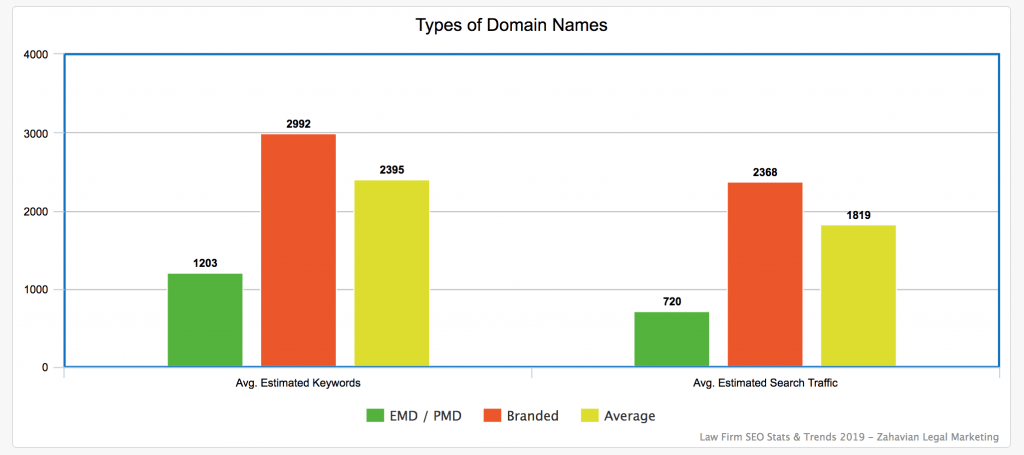
As part of our research, we gathered data from Ahrefs on the keywords for each law firm’s website as well as its estimated organic traffic.
| Domain Name Type | Avg. # Keywords | Avg. Est. Organic Traffic |
| EMD / PMD | 1203 | 720 |
| Non-EMD / PMD | 2992 | 2368 |
| Aggregate | 2395 | 1819 |
Exact and partial match domains ranked for significantly fewer keywords and organic traffic than law firm’s that didn’t use these types of domains. When this data is compared with the data on referring domains (i.e. links), there’s a significant trend that the top ranking websites which employ keyword-rich domain names invest far less effort than their counterparts in achieving these short-tail keyword rankings.
Notes: 1) I encourage people to be careful in choosing domain names simply for the sake of ranking in search. If your law firm’s primary focus is on that area of practice, then it may be warranted. 2) Full disclosure: Keywords and Organic Traffic can be strong indicators of SEO health to consider and measure. However, these alone don’t mean that all of the keywords a site ranks for and its organic traffic is relevant. This study didn’t go as far as to look at keyword and traffic relevance, only the summarized metrics.
Rationale
Partial and Exact match domains for the sake of the numbers are grouped together. While we’ve seen an example of an exact match domain. For the purposes of this report, we have defined a partial match domain as containing 2 or more keywords within the domain. These tend to be partial match due to the brand name being included in the domain name. For example, if the Johnson Law Firm used a domain of johnsonfamilylawyers.com, then this would count as a PMD (partial match), since it contains “family lawyers” in the domain. Additionally, if Johnson used a domain of www.johnsonmiamilaw.com, then this would also be counted as a PMD in our results.
Use of Branded Domains
At this point, you may think there’s less weight or more work to be done with domains that don’t include target, search keywords – such as a branded domain. However, we found that 82.9% of law firm’s website ranking on the first page contained their firm’s brand in the domain name.
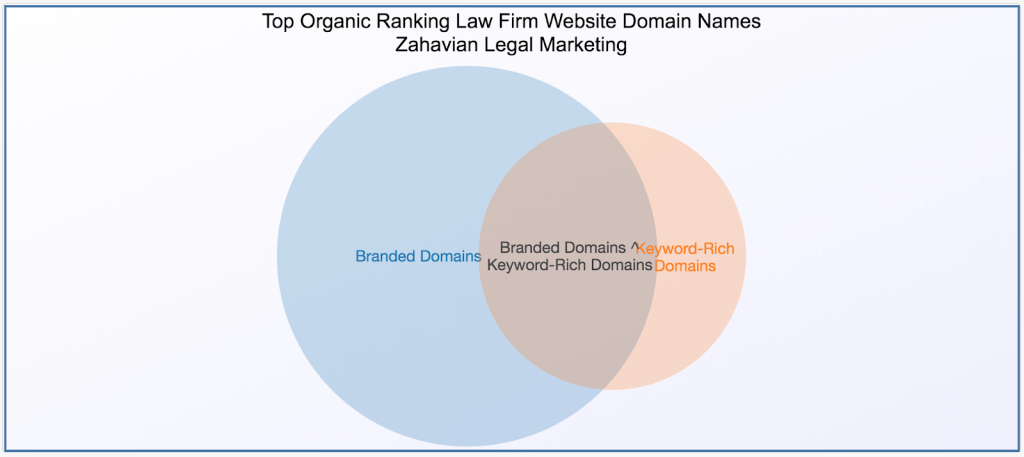
The figure above clearly illustrates the characteristics of domain names and overlap found in the dataset. The majority of domain names were brand-only (57%), whereas 26% of domain names included both brand and search keywords.
6. Law Firms with a Primary Area of Practice
Coming back to the point of EAT (Expertise, Authoritativeness and Trust), Google is putting more weight and significance on websites based on these 3 factors. While the study doesn’t look at trust, as it is difficult to measure for many reasons (I would argue that even the best of the search engines can’t measure this properly, in many regards), we can look at how many law firms ranking on the first page focus on specific areas of practice, rather than offer a full range of legal services.
In short, here were our findings:
- 91.7% of law firms ranking on page 1 for “personal injury lawyer” + “city” were firms specializing in personal injury law
- 94.4% of practices ranking for “criminal lawyer” + “city” focused on criminal defense
- 86.9% of firms ranking for “family lawyer” + “city” were family law-only law firms
While this doesn’t exactly indicate that these firms are experts (as bar rules prohibit lawyers from claiming expertise), Google seems to correlate exclusivity with expertise.
7. Use of Target Keywords Title Tags and URLs
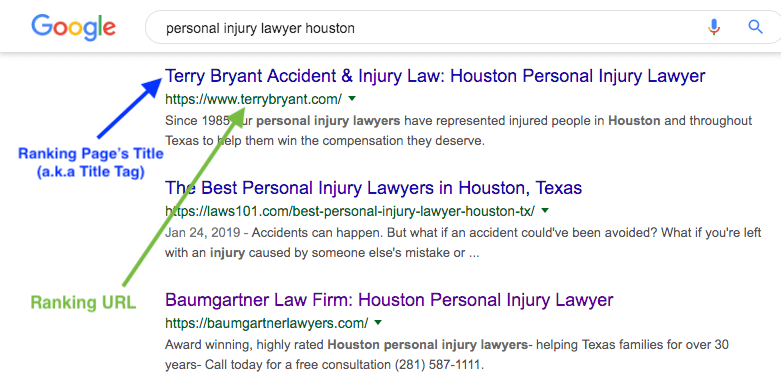
Among some of the smaller, yet more important on-page SEO properties are the title tag and full URL. For reference, the average Title Length displayed on Google was 56 characters and 34 characters for the URLs. Keep in mind that these included truncated titles (cut-off around 65 chars).
Title Tag Observations
What we discovered was that 89.7% of law firm’s webpages on the first SERP have the search keyword or stemming of the keyword (e.g. “family lawyer”, “family law”, “family lawyers”, etc.) in the title tag. Furthermore, 95.1% of ranking firms’ pages contained the name of the city or the state within the Title tag. The vast majority of them had city names rather than the state names in the title.
Note: Keep in mind that this study conducted searches with city keywords only, not state. There is still large search volumes for lawyer and firm using state names or abbreviations, rather than cities. We simply didn’t conduct those search queries in this study.
Upon further investigation, we found that when broken down by area of practice, each of the ranking pages’ titles contained the following.
Personal Injury – 100% of the law firm web pages in search results contained either “injury”, “accident”, “disability” or “insurance claim” in the title.
Criminal Law – 100% of the page title tags contained “criminal”, “DUI” or “DWI” in the title tag.
Family Law – 100% of the law firm and attorney pages ranking on page 1 had a title that contained “family”, “child custody”, “spousal support” or “divorce”.
Several things to be aware of:
- Titles also contained at least one keyword (or stemming) such as law, law firm, lawyer, attorney, etc.
- This was not an exhaustive study. If this were extended to cities and states across all of North America, the results probably wouldn’t sustain rates of 100%.
Even with those points in mind, those are pretty compelling findings in terms of the importance and relevance of a well-optimized title tag.
URL Observations
51.2% of the URLs included either the city, at least one area of practice keyword or both. In the outset of this section, it was mentioned that the average URL length was 34 characters. This may sound relatively short until you discover that 87.8% of the first-page results were directed to the website’s homepage rather than an inner page. This could be due to one of two reasons:
- Most of the results are for law firms that specialize in the areas of law they’re ranking for in search. Hence the home page makes sense to rank
- In general, homepages (root URLs) attract the most backlinks and referring domains, hence have the highest page authority from a link equity perspective.
Beyond these two points, 41% of the domains found in the study were either exact or partial match domains. Meaning that the keywords observed in 51.2% of the URLs were already present in the domain name.
8. Time Since Last Update or Re-Design
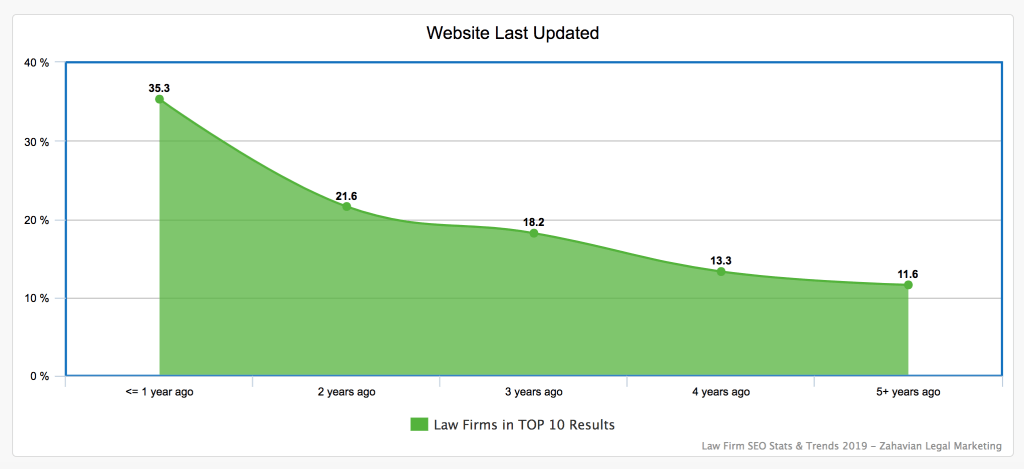
Using web.archive.org, we were able to measure (approximately) how long ago each law firm’s website was re-designed or experienced a major refresh. This isn’t an SEO ranking signal, rather a signal of how invested a firm is in its website. The evidence of sites ranking in the top positions in organic search showed a clear descending trend in time since last update.
| Website Last Updated | % of Law Firm Websites of Page 1 |
| <= 1 year ago | 35.3% |
| 2 years ago | 21.6% |
| 3 years ago | 18.2% |
| 4 years ago | 13.3% |
| 5+ years ago | 11.6% |
Another way to look at this data is that 75.6% of law practice websites ranking in the top 10 results saw significant updates or were re-designed in the past 3 years. Only 24.4% of firm sites were 4 years or older, in terms of major on-site changes.
9. WordPress is CMS of Choice

Interestingly the majority of law firms’ websites ranking on the first page of Google organic results are built on a CMS (content management system). More specifically, 62.2% of all firm sites on page 1 are built with WordPress. Being the most popular CMS globally, this isn’t a surprise that it’s the most popular for lawyers. However, it is interesting that so many legal WordPress sites are dominating the search results.
WordPress isn’t an SEO ranking signal or factor in search engine algorithms. However, it is a testament to the power and flexibility of the WordPress ecosystem. It features endless customizability in building and designing a tailored site while being relatively ready out of the box for on-page SEO and offering some of the best extensible functionality in the form of plugins. It’s hard to argue with this stat. If so many WordPress sites are ranking so highly in the Google SERPs, you should strongly consider going with (or sticking with) WordPress for your law firm’s website.
10. Mobile-Ready and Site Performance
While we only measured lawyer websites on the first page via a desktop browser, we wanted to see how many were mobile-responsive. In short, all of the websites which constituted this study’s dataset had a mobile version or was mobile-responsive.
Page Speed
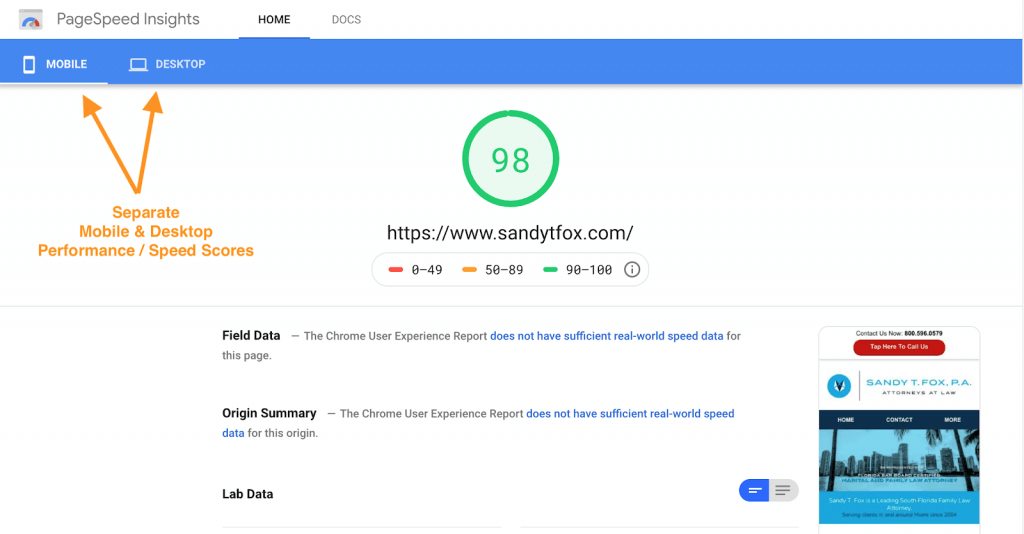
We constantly hear how important site speed is. We decided to look at how the top-ranking attorney websites perform in terms of speed and efficiency. For the test, we checked the site performance using Google’s free PageSpeed Insights tool. This tool ranks the speed of a particular webpage (on a scale out of 100). In short, it produces separate scores for mobile and desktop.
Overall, sites received an average score of:
- 44.2 on mobile
- 75.9 on desktop
Knowing that the majority of legal practice’s sites occupying the top 10 positions were built on WordPress, we were curious as to how well they performed compared to their non-WP counterparts.
| Type of Law Firm Site | Avg. Mobile Speed Score | Avg. Desktop Speed Score |
| WordPress-powered Websites | 32.8 | 66.8 |
| Non-WP Website | 62.8 | 90.8 |
| Aggregate | 44.2 | 75.9 |
A distinct difference between WordPress site performance on both mobile and desktop. On average, attorney sites that didn’t use WordPress backend scored nearly twice as well on mobile as ones that did. On average, Non-WP sites also scored 24 points higher for the desktop test as well. Apparently, WordPress sites still perform well while sacrificing site speed.
More for CRO (conversion rate optimization) than a ranking factor, site speed, like SSL, can still add up in giving you an edge over the competition (all else being equal).
Note: You don’t need to make a compromise between site speed and WordPress. A well-optimized WordPress site can match in terms of the PageSpeed benchmarks.
11. Conversion Rate Optimization Features
When it comes to generating as much potential revenue from your website as possible, CRO is what you’ll want to implement. This is more of studying trends than SEO and ranking factors. However, one could argue that CRO is still an important part of user experience, which google does take into great consideration. Law firms that invest in SEO and internet marketing are bound to invest the incremental amount it takes to squeeze as much value out of their sites as possible.
Some of the more common CRO features you should consider implementing into your site’s design are the following:
- Use static images instead of image sliders
- Place your Phone # of Call to Action (CTA) in the top right corner
- Place at least one Call to Action above the fold (above the page cut-off point in your browser)
So, we tallied how many of the sites we collected are using this one their ranking pages. The results were quite re-assuring:
- 65.9% of practices had a CTA or Phone Number in the top right corner of the website
- 78.1% contained at least one CTA above the fold
- 65.9% also used static images
12. Blogging, Keywords & Traffic
One of the most powerful ways for lawyers to compete for cases and clients online, through search is by blogging and content marketing. We found that 82.9% of law firms benefiting from being on the first page for their primary, short-tail keywords are blogging.
We allowed for the website’s blogging approach to be flexible. Some law firm brand their blog as an “Information Center” or “Help Center”. In some cases, it’s referred to as “Articles” or “Library”, and many simply call it a blog. Any and all of these were considered a blog.
Effects of Blogging on Keyword Rankings & Search Traffic Volume
| Blog Status | # Keywords | Est. Site Traffic | Referring Domains | # Backlinks |
| Actively Blogging | 5389 | 3083 | 215 | 11779 |
| Inactive Blog | 1174 | 614 | 107 | 2527 |
| Blog (Aggregate) | 4645 | 2647 | 196 | 10147 |
| No Blog | 287 | 182 | 116 | 17303 |
Active Blogs
In this study, we defined actively blogging as having written at least 2 articles in the past 3 months. Any older than that, and it’s considered an ‘inactive’ blog for the purposes of this study. 68.3% of all law firm websites studied were found to be actively blogging.
Law Firms Win When They Blog Actively and Consistently
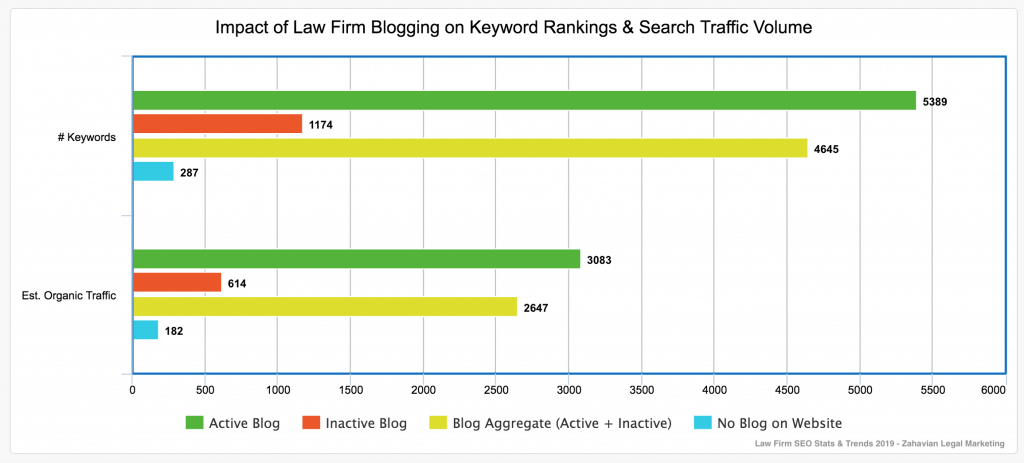
Law firms that were actively blogging on their website generated significantly more traffic and ranked for more keywords than websites without blogs or inactive blogs. In fact, law firms actively updating and adding content to their blogs ranked 359% more keywords and pulled in over 400% more traffic than law firms with inactive blogs.
Contrast that with websites without blogs and the distance gets even wider. Law firms consistently adding blogs and articles to their sites ranked for 17.8 times the number of keywords and 15.9 times more traffic than firm websites without blogs.
When we look at the backlinks data, there’s an interesting relationship between active blogs and a significant increase in referring domains, compared to the rest. While we can’t comment on the linking strategy, it’s noteworthy to observe the difference between active, inactive and sites without a blog. For instance, on average, law firms actively blogging on their websites were linked to nearly twice as often from other websites as law firms with no blog (215 RDs vs 116 RDs).
Conclusion
There are many things that we didn’t cover in this report. We could have gone further into analyzing on-page SEO metrics, like heading tags, number of images, meta descriptions and so on. However, we thought it was important to discuss several of the basics and then dive deeper to look at the trends and statistics of law firm websites, what they’re doing and how that added into their overall SEO strategy.
If you’re interested in learning how we went about studying these websites and a little of the methodology, check out the section below.
How Did We Collect and Analyze the Data?
We selected a small sample of 9 North American cities (4 Canadian + 5 US) and 4 general attorney-related, short-tail keywords to be analyzed in the study. There was nothing particularly special about the cities selected, aside from the fact that they were generally larger economic and populous hubs (with the exception of Ottawa, CA).
As for the short-tail keywords, we opted for keywords due to 2 reasons. Effectively, they had relatively:
- High AdWords CPC/competition
- High search volume for that legal matter/area of law
Search results were collected by performing searches for [keyword] + [city] (e.g. “family lawyer miami”). From that, only search results that matched website for law firms were collected. Other websites such as Avvo, SuperLawyers, Nolo, FindLaw that were ranking on page 1 were not accounted for.


